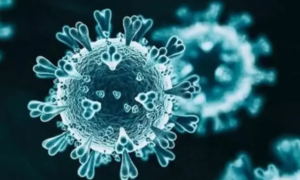
It’s in China! Can the new strain CH.1.1 cause secondary infections? CDC’s latest study

Recently, a variant of Omicronia named CH.1.1 appeared in the United States. According to China News, it belongs to a branch of the mainstream strain BA.2.75, which some experts have named “Orthrus” (a two-headed dog in Greek mythology). Studies have shown that CH.1.1 is potentially more infectious and immune evasive than other new coronavirus subvariants, and may cause more severe disease.
On January 31, the CDC issued a paper showing that as of January 30, 2023, a total of 24 imported cases of CH.1.1 and its sub-branches have been monitored.
Surveillance has detected in 67 countries or regions
According to the CDC, the GISAID database inclusion sequence shows that CH.1.1 was first collected and detected in India on July 8, 2022. In the last 1 month, CH.1.1 and its subbranches accounted for more than 6% of the global sequence count. As of January 30, 2023, it has been detected in 67 countries or regions under surveillance, and is prevalent mainly in the UK, Denmark, and Singapore, accounting for approximately 25% of the new coronavirus sequences uploaded in the UK in the last month.
From November 2022 to the present, the proportion of CH.1.1 in the epidemic strains of new coronaviruses in the U.S. has been on the rise. in week 4 of 2023, CH.1.1 was the fifth most prevalent strain in the U.S., after XBB.1.5, BQ.1.1, BQ.1 and XBB mutant strains.
Also as previously reported by Health Times, data from the outbreak tracking data site Outbreak.info shows that New Zealand is currently experiencing many cases of CH.1.1. Other hotspots include Papua New Guinea, Cambodia, Ireland and others. The strain has been detected in over 60 countries and 51 U.S. states.
How pathogenic is it?
According to the CDC, CH.1.1 belongs to the sixth generation subbranch of the Omicron mutant strain BA.2.75. The latest study showed that the immune escape ability of CH.1.1 was increased due to the addition of several new mutant loci. Meanwhile, one of the added mutant sites (L452R) used to be a characteristic mutation site of the Delta mutant strain. However, it is noteworthy that this mutant locus is also present in many other subbranches of the Omicron variant strain, such as BA.5.3 and BA.5.1.3.
Also according to CNN, researchers at Ohio State University say that CH.1.1 binds well to the ACE2 receptor, which is the receptor that mediates the entry of new coronaviruses into host cells, meaning it has the potential to break, at least partially, through antibody immunity developed by the body after prior infection and vaccination.

The researchers found that CH.1.1 showed a remarkable ability to evade the neutralizing effect of the new version of the vaccine booster. While subtype variants of CH.1.1, XBB.1.5 and CA.3.1 are all growing proportionately worldwide, infectious disease experts are unsure whether the latest strains will trigger another wave of new crown infections and hospitalizations.
Cornelius Romer, an Omicron variant tracker and computational biologist at the University of Basel in Switzerland, said CH.1.1 is like XBB.1.5 in that it is highly transmissible, with levels doubling every two weeks or so.
Currently, according to the CDC, no enhanced pathogenicity of the CH.1.1 variant has been seen, and further attention is still needed. Generally after the emergence of a new strain, infected cases need to reach a certain size and last for a certain period of time before the pathogenicity of the new strain can be initially judged to be changed.

On the question of whether CH.1.1 will cause a second round of infection, the CDC said that although the immune escape ability and transmission advantage of the CH.1.1 mutant strain have further increased, leading to an increased risk of breakthrough infection and reinfection, high levels of neutralizing antibodies already exist in most of the population in China, and there is some cross-protection against CH.1.1. CH.1.1 will not cause a local CH.1.1 will not cause a large-scale epidemic in the short term. Vulnerable populations (elderly people over 65 years old, patients with underlying diseases and unvaccinated people) and uninfected people still need to strengthen personal protection. In addition, the article mentions that in the face of CH.1.1, one should insist on good personal protection, maintain good hygiene practices, and not believe unconfirmed internet reports.
24 imported cases found in China
According to the CDC, on November 13, 2022, CH.1.1 evolutionary branch was detected for the first time in China by genome sequencing from a sample of an imported case from Thailand (sampled on November 10, 2022) reported by Tianjin. As of January 30, 2023, a total of 24 imported cases of CH.1.1 and its subbranches were detected through surveillance. The origin of imported cases involved 15 countries or regions. No indigenous infection cases of CH.1.1 and its subbranches were monitored.
“According to the official website of the CDC informing the national epidemic of novel coronavirus infections, the prevalent strains of the recent epidemic in China remain BA.5.2 and BF.7, and no new mutant strains have been found.” Zhao Wei, director of the Center for Biosecurity Research at the School of Public Health of Southern Medical University, previously interviewed by the People’s Daily Health Client, said, “This shows on the one hand that our national quarantine work is effective and can prevent the large-scale entry of new mutant strains from abroad into our country. On the other hand, the large-scale epidemic in China has just been controlled, and the immune barrier of the population is at a relatively high level, so we can judge that the recent Omicron subvariant is less threatening to China.”


Average Rating